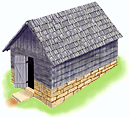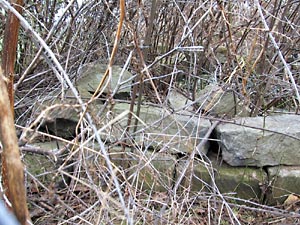by Frederick Smoot


GENEALOGY will lead the ardent researcher down many roads. Obscure burial grounds and lesser known burial customs can be the reward for following those roads. One reward could be the discovery of the ruins of a grave house, sometimes called a grave shelter. They can be found throughout the south, especially in hill country. The grave house is different from the mausoleum. The grave house is built over an “in earth” interment, while in the mausoleum the bodies are above ground, often being placed in a alcove in the walls. As we might expect, our early grave houses may contain more than one body. The style of the grave house could vary. Logs, milled lumber, field stones, ashlars, and even brick are the potential materials of the grave house. Some grave houses were built without doors. Many abandoned early grave houses would have totally disappeared as the wooden parts rotted away. Those grave houses that had a stone perimeter foundation may today appear simply as old stone walls - and if no headstones remain -- may be passed over as cemetery - looking too much like the foundation of a small building.
GRAVE HOUSEANDERSON CEMETERY“A shelter erected over or near a grave.” [2] “Many of them [mountain cemeteries] have ‘grave houses’ - rude log and clapboard shelters - that many mountaineers customarily erect over and around the graves of their relatives.” [3] “In the earlier days when a body of a loved one . . . was consigned to the earthly bosom of the hill country, a grave house was erected over the mound. These little houses protected the grave from both the elements and that fiendish ghoul, the grave robber.” [DAR]

Stone foundation of the Anderson Grave House
This cemetery is situated in Warren County Tennessee on the south side of Old Shelbyville Road, east of Old Well Road. It is both south and west of the Barren Fork River, south of the Garner Branch. The roof is missing, no headstones are visible. The neighborhood tradition names this little graveyard, the “Anderson Cemetery.”
My first experience with a grave house was when Wm. Butler Smith, a lifetime Warren County citizen, showed this “grave house” cemetery to me. It was totally full of brush and we were not able to see inside. Cut stone walls enclosed the cemetery, many stones had been pushed in by cattle. The exterior measurements of the walls are 22 feet by 12 feet, with a height of 3 feet. Butler was of the opinion that the native stone walls were “slave built.” He said “White men don’t work that hard.”
Butler told the story that as a boy (1930’s) he had hunted rabbits on that hillside and once, while hunting he had looked under the rotting & fallen roof of the cemetery and he saw a rabbit among the graves. He declined to shoot the rabbit saying that he did not want to crawl under the roof because of the possibility of snakes. Butler said grave stones numbered 5 or 6. The gravestones were rough cut native stone, not the fancy marble gravestones that see in latter times. Butler stated that the grave house had no wood walls above the stone foundation, and never had. The roof was built directly atop the stones. There is no documented date for this cemetery. For good cause, I date this cemetery as the 1830’s.
Some miles to the south, in Coffee County, Deed Book “B” we see documentation of the Thos. Brixey Grave House grave house dating 1841.
THOS BRIXEY GRAVE HOUSE

Stone foundation of the Brixey Grave House
This cemetery is situated in Coffee County. The roof is missing.
From Coffee County Tennessee, Deed Book B., pp. 338-9
No. 32 Covenant between the heirs of Thos Brixey.GRAVE HOUSE STYLES
We the Undersigned do hereby Covenant and agree that John O. Brixey and Samuel F. Brixey administrators of Thos Brixey deceased employ some person or persons to inclose the Graves of Thos Brixey Susanna Brixey his wife and Parthenia Brixey with a wall of Rock three feet high and plate rafters and shingles above the wall also the gables ends weatherboarded up and we do also Covenant and agree that the expense be charged to us jointly and that each and every one pay an equal part all the above work to be done in good work-man style. Witness our hand and seal this 2nd day of October 1841.
Executed in presence of us :
Abner Duncan
G. W. Carpenter
Walton Brixey (seal)
Uriah Sherrill (seal)
Stiars A Nash (seal)
John O. Brixey (seal)
W. L. Brixey (seal)
S. F. Brixey (seal)
P. Wilkins (seal)
Many variations of grave house styles can be seen in an excellent article, by Donald B. Ball that covered the study of some grave houses in Cannon, Coffee, and Rutherford Counties. The article is titled Observations on the Form and Function of Middle Tennessee Gravehouses. [TA]
In the article are photographs of a variety of styles, from little wooden structures that look like garden gazebos to tiny finished stone structures that appear to be miniature mausoleums. Most pleasing to me was the inclusion of a small drawing of a grave house with short ashlar walls, no wood walls, but a roof directly atop the ashlars. This little drawing showed me that my own drawings were accurate.
Those grave houses that had wood walls or picket fences could be painted. I have read of a grave house in East Tennessee (now razed) that had wood walls that were painted black.
The question of why were so many grave houses placed in hillside locations, might be best answered by a friend of mine from West Virginia hill country. He has told me that where he was born, there were a lot of hills, and hillside grave houses, but only very narrow “hollars.” He said that hillside burials are done for the same reasons that fence row burials were done: the bodies are out of the way, they won’t be plowed up, and you do not waste precious farm land. He notes that hillside cemetery locations are preferred, especially if the graves can be faced eastward. That way, the interred souls may the first to see the next coming of the Messiah.
ENDNOTES
[DAR] Cassidy, Frederick, Chief Editor. Dictionary of American Regional English, Vol. II, ( DARE ) Belknap Press of Harvard University Press, Cambridge, Massachusetts. 1991. Three references are given in DARE, all from Kentucky. Reference #3: 1942 Clark Kentucky 196 KY.
Reprinted with permission.
[TA] Ball, Donald B., Tennessee Anthropologist, Journal of the Tennessee Anthropological Association, Volume II, Number 1, Spring 1977.
CREDITS
1. Martha Holt, Warren County cemetery expert. She knew of the Anderson Cemetery, and she pointed me in the right direction.
2. Wm Butler Smith, who literally knows where the bodies are buried.
3. Betty Moore Majors, P. G., who found the Thos Brixey grave house Covenant, and shared it with me.
4. Stever Rogers, Historic Preservation Specialist, Tennessee Historical Commission, who gives expert advise.
5. Rodger Pauley, a West Virginian with stories.
† This paper was originally published in the Middle Tennessee Journal of Genealogy & History, Volume XI, 3, 99 as “The Middle Tennessee Grave House.”